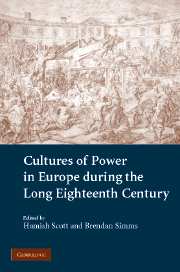Book contents
- Frontmatter
- Contents
- Preface
- List of contributors
- 1 Introduction: culture and power during the long eighteenth century
- 2 When culture meets power: the Prussian coronation of 1701
- 3 Military culture in the Reich, c. 1680–1806
- 4 Diplomatic culture in old regime Europe
- 5 Early eighteenth-century Britain as a confessional state
- 6 ‘Ministers of Europe’: British strategic culture, 1714–1760
- 7 Confessional power and the power of confession: concealing and revealing the faith in Alpine Salzburg, 1730–1734
- 8 The transformation of the Aufklärung: from the idea of power to the power of ideas
- 9 Culture and Bürgerlichkeit in eighteenth-century Germany
- 10 The politics of language and the languages of politics: Latin and the vernaculars in eighteenth-century Hungary
- 11 ‘Silence, respect obedience’: political culture in Louis XV's France
- 12 Joseph II, petitions and the public sphere
- 13 The court nobility and the origins of the French Revolution
- 14 The French Revolution and the abolition of nobility
- 15 Foreign policy and political culture in later eighteenth-century France
- 16 Power and patronage in Mozart's La clemenza di Tito and Die Zauberflöte
- 17 Between Louis and Ludwig: from the culture of French power to the power of German culture, c. 1789–1848
- Index
17 - Between Louis and Ludwig: from the culture of French power to the power of German culture, c. 1789–1848
Published online by Cambridge University Press: 17 July 2009
- Frontmatter
- Contents
- Preface
- List of contributors
- 1 Introduction: culture and power during the long eighteenth century
- 2 When culture meets power: the Prussian coronation of 1701
- 3 Military culture in the Reich, c. 1680–1806
- 4 Diplomatic culture in old regime Europe
- 5 Early eighteenth-century Britain as a confessional state
- 6 ‘Ministers of Europe’: British strategic culture, 1714–1760
- 7 Confessional power and the power of confession: concealing and revealing the faith in Alpine Salzburg, 1730–1734
- 8 The transformation of the Aufklärung: from the idea of power to the power of ideas
- 9 Culture and Bürgerlichkeit in eighteenth-century Germany
- 10 The politics of language and the languages of politics: Latin and the vernaculars in eighteenth-century Hungary
- 11 ‘Silence, respect obedience’: political culture in Louis XV's France
- 12 Joseph II, petitions and the public sphere
- 13 The court nobility and the origins of the French Revolution
- 14 The French Revolution and the abolition of nobility
- 15 Foreign policy and political culture in later eighteenth-century France
- 16 Power and patronage in Mozart's La clemenza di Tito and Die Zauberflöte
- 17 Between Louis and Ludwig: from the culture of French power to the power of German culture, c. 1789–1848
- Index
Summary
In his award-winning study of old regime culture, The Culture of Power and the Power of Culture, Tim Blanning shows how the representational culture that had dominated the European cultural scene for the best part of a century, was progressively eroded by the rise of the public sphere. In this essay, I shall attempt to take Blanning's treatment of European culture beyond the momentous watershed of 1789, by extending it through the revolutionary and Napoleonic period into the restoration era, which was brought to a close by the return of revolution to the continent in 1848. To this end, I want to suggest that if the eighteenth century was dominated by the culture of French power, then the first half of the nineteenth was dominated by the power of German culture.
If the culture of French power had been synonymous with the name Louis XIV and Versailles, the power of German culture was bound to that of Ludwig I of Bavaria and his capital, Munich. Between 1825 and 1848, this ‘artist king’ transformed Bavaria into the ‘kingdom of art’. As one contemporary observer explained:
When the art-loving prince ascended the throne in the year 1825, there were no more significant buildings in Munich than the breweries. The old Bavarian was born, drank beer and then passed away. Foreigners came to Munich – whose art treasures were at that time limited to the designs on its beer tankards – mostly by accident or driven by desperate thirst. Then King Ludwig waved his mighty wand, and with one great magic stroke, a new life emerged in sluggish Bavaria. Ancient temples for the sacred objects of art rose up from the ground, magnificent churches next to them, streets upon streets appeared, statues were placed in public squares, the call was sent out to painters, scholars and poets.
- Type
- Chapter
- Information
- Cultures of Power in Europe during the Long Eighteenth Century , pp. 348 - 368Publisher: Cambridge University PressPrint publication year: 2007



